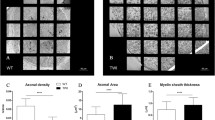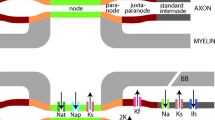Summary
Progressive axonopathy is an autosomal recessive inherited neuropathy of Boxer dogs with lesions in the CNS and PNS. This paper describes the axonal changes in the lumbar and cervical nerve roots and tibial nerve. By 2 months of age the proximal paranodal areas of many larger diameter fibres show small axonal swellings, sometimes with attenuation or loss of the associated myelin sheath. Axoplasmic changes within swollen and non-swollen fibres include disorganization of the peripheral neurofilaments and small accumulations of vesicles and vesiculo-tubular profiles, particularly in the sub-axolemmal area. Occasional fibres, more often in the cervical roots, are massively distended with disorganized neurofilaments.
The frequency of the membranous accumulations decreases with progression of the disease. Many axons show a markedly irregular or corrugated outline and are surrounded by an attenuated sheath. The peripheral axonal cytoskeleton is disorganized and misaligned, whereas the central structures maintain a more normal arrangement. Regenerating axonal clusters are common in the cervical ventral roots but occur infrequently in the lumbar roots.
Similar axonal changes occur in the peripheral nerves but at a much lower frequency. Any membranous accumulations or cytoskeletal disorganization are more probable in the proximal tibial nerves, while the frequency of axonal degeneration and regeneration increases distally. The morphological appearances indicate gross disturbances in axon-sheath cell relationships and suggest that abnormalities in the transport of various axoplasmic organelles may be involved in the pathogenesis of the axonal lesion.
Similar content being viewed by others
References
Anthony, D. C., Boekelheide, K. &Graham, D. G. (1983) The effect of 3, 4-dimethyl substitution on the neurotoxicity of 2, 5-hexanedione. 1. Accelerated clinical neuropathy is accompanied by more proximal axonal swellings.Toxicology and Applied Pharmacology 71, 362–71.
Baitinger, C., Levine, J., Lorenz, T., Simon, C., Skene, P. &Willard, M. (1982) Characteristics of axonally transported proteins. InAxoplasmic Transport (edited byWeiss, D. G.), pp. 110–20. Berlin: Springer-Verlag.
Berthold, C-H. (1982) Some aspects of the ultrastructural organisation of peripheral myelinated axons in the cat. InAxoplasmic Transport (edited byWeiss, D. G.), pp. 40–54. Berlin: Springer-Verlag.
Bizzi, A., Crane, R. C., Autilio-Gambetti, L. &Gambetti, P. (1984) Aluminium effect on slow axonal transport: a novel impairment of neurofilament transport.Journal of Neuroscience 4, 722–31.
Bouldin, T. W. &Cavanagh, J. B. (1979) Organophosphorus neuropathy. II. A fine structural study of the early stages of axonal degeneration.American Journal of Pathology 94, 253–70.
Broadwell, R. D. &Cataldo, A. M. (1984) The neuronal endoplasmic reticulum: its cytochemistry and contribution to the endomembrane system. II. Axons and terminals.Journal of Comparative Neurology 230, 231–48.
Cavanagh, J. B. (1982) The pattern of recovery of axons in the nervous system of rats following 2, 5-hexanediol intoxication: a question of rheology.Neumpathology and Applied Neurobiology 8, 19–34.
Chretien, M., Patey, L., Souyr1, F. &Droz, B. (1981) ‘Acrylamide-induced’ neuropathy and impairment of axonal transport of proteins. II, Abnormal accumulations of smooth endoplasmic reticulum as sites of focal retention of fast transported proteins. Electron microscopic autoradiographic study.Brain Research 205, 15–28.
Clark, A. W., Griffin, J. W. &Price, D. L. (1980) The axonal pathology in chronic I.D.P.N. intoxication.Journal of Neuropathology and Experimental Neurology 39, 42–55.
Droz, B., Chretien, M., Souyri, F. &Patey, G. (1982) Axoplasmic transport in the experimental neuropathy induced by acrylamide. InAxoplasmic Transport in Physiology and Pathology (edited byWeiss, D. G. &Gorio, A.), pp. 104–8. Berlin: Springer-Verlag.
Ellisman, M. H. &Lindsey, J. D. (1982) Organisation of axoplasm — membranous and fibrillar components possibly involved in fast neuroplasmic transport. InAxoplasmic Transport (edited byWeiss, D. G.), pp. 55–63. Berlin: Springer-Verlag.
Grafstein, B. &Forman, D. S. (1980) Intracellular transport in neurones.Physiological Reviews 60, 1167–283.
Graham, D. G. (1980) Hexane neuropathy: a proposal for the pathogenesis of a hazard of occupational exposure and inhalant abuse.Chemical-Biological Interactions 32, 339–45.
Griffin, J. W., Fahnestock, K. E., Price, D. L. &Hoffman, P. N. (1983) Microtubule-neurofilament segregation produced by B, B-iminodipropionitrile: evidence for the association of fast axonal transport with microtubules.Journal of Neuroscience 3, 557–66.
Griffin, J. W., Hoffman, P. N., Clark, A. W., Carroll, P. T. &Price, D. L. (1978) Slow axonal transport of neurofilament proteins: impairment by B, B-iminodipropionitrile administration.Science 202, 633–5.
Griffin, J. W., Hoffman, P. N. &Price, D. L. (1982) Axonal transport in B, B-iminodipropionitrile neuropathy. InAxoplasmic Transport in Physiology and Pathology (edited byWeiss, D. G. &Gorio, A.), pp. 109–18. Berlin: Springer-Verlag.
Griffin, J. W. &Price, D. L. (1981) Demyelination in experimental B, B-iminodipropionitrile and hexacarbon neuropathies. Evidence for an axonal influence.Laboratory Investigation 45, 130–41.
Griffin, J. W., Price, D. L. &Drachman, D. B. (1977a) Impaired axonal regeneration in acrylamide intoxication.Journal of Neurobiology 8, 355–70.
Griffin, J. W., Price, D. L., Engel, W. K. &Drachman, D. B. (1977b) The pathogenesis of reactive axonal swellings: role of axonal transport.Journal of Neuropathology and Experimental Neurology 36, 214–27.
Griffiths, I. R. (1985) Progressive Axonopathy: an inherited neuropathy of Boxer dogs. 1. Further studies of the clinical and electrophysiological features.Journal of Small Animal Practice 26, 389–92.
Griffiths, I. R. &Duncan, I. D. (1975) Age changes in the dorsal and ventral lumbar nerve roots of dogs.Acta neuropathologica (Berlin) 32, 75–85.
Griffiths, I. R., Duncan, I. D. &Barker, J. (1980) A progressive axonopathy of Boxer dogs affecting the central and peripheral nervous sytems.Journal of Small Animal Practice 21, 29–43.
Griffiths, I. R., Duncan, I. D. &McCulloch, M. (1981) Shaking pups: a disorder of central myelination in the spaniel dog. II. Ultrastructural observations on the white matter of the cervical spinal cord.Journal of Neurocytology 10, 847–58.
Griffiths, I, R., McCulloch, M. &Abrahams, S. (1985) Progressive Axonopathy: an inherited neuropathy of Boxer dogs. 2. The nature and distribution of the pathological changes.Neuropathology and Applied Neurobiology, in press.
Hoffman, P. N., Griffin, J. W. &Price, D. L. (1984) Control of axonal calibre by neurofilament transport.Journal of Cell Biology 99, 705–14.
Hoffman, P. N. &Lasek, R. J. (1975) The slow component of axonal transport. Identification of major structural polypeptides of the axon and their generality among mammalian neurons.Journal of Cell Biology 66, 351–66.
Jakobsen, J. &Brimijoin, S. (1981) Axonal transport of enzymes and labelled proteins in experimental axonopathy induced by p-bromophenylacetylurea.Brain Research 229, 103–22.
Jones, H. B. &Cavanagh, J. B. (1983) Distortions of the nodes of Ranvier from axonal distension by filamentous masses in hexacarbon intoxication.Journal of Neurocytology 12, 439–58.
Langford, L. A. &Coggeshall, R. E. (1980) The use of potassium ferricyanide in neural fixation.Anatomical Record 197, 297–303.
Lasek, R. J., Garner, J. A. &Brady, S. T. (1984) Axonal transport of the cytoplasmic matrix.Journal of Cell Biology 99, 212s-21s.
Papasozomenos, S. C., Autilio-Gambetti, L. A. &Gambetti, P. (1981) Reorganisation of axoplasmic organelles following B, B-iminodipropionitrile administration.Journal of Cell Biology 91, 866–71.
Papasozomenos, S. C., Autilio-Gambetti, L. A. &Gambetti, P. (1982) The I.D.P.N. axon: rearrangement of axonal cytoskeleton and organelles following B, B-iminodipropionitrile (I.D.P.N.) intoxication. InAxoplasmic Transport (edited byWeiss, D. G.), pp. 241–50. Berlin: Springer-Verlag.
Raine, C. S. (1982) Differences between the nodes of Ranvier of large and small diameter fibres in the P.N.S.Journal of Neurocytology 11, 935–47.
Rambourg, A. &Droz, B. (1980) Smooth endoplasmic reticulum and axonal transport.Journal of Neurochemistry 35, 16–25.
Rydmark, M. &Berthold, C-H. (1983) Electron microscopic serial section analysis of nodes of Ranvier in lumbar spinal roots of the cat: a morphometric study of nodal compartments in fibres of different sizes.Journal of Neurocytology 12, 537–65.
Sahenk, Z. &Mendell, J. R. (1980) Zinc pyridinethione. InExperimental and Clinical Neurotoxicology (edited bySpencer, P. S. &Schaumburg, H. H.), pp. 578–92. Baltimore: Williams and Wilkins.
Simonati, A., Rizzuto, N. &Cavanagh, J. B. (1983) The effects of 2, 5-hexanedione on axonal regeneration after nerve crush in the rat.Acta neuropathologica (Berlin) 59, 216–24.
Spencer, P. S. &Griffin, J. W. (1982) Disruption of axoplasmic transport by neurotoxic agents. The 2, 5-hexanedione model.In Axoplasmic Transport in Physiology and Pathology (edited byWeiss, D. G. &Gorio, A.), pp. 92–103. Berlin: Springer-Verlag.
Spencer, P. S. &Schaumburg, H. H. (1977) Central-peripheral distal axonopathy — The pathology of dying-back polyneuropathies.Progress in Neuropathology 3, 253–95.
Spencer, P. S. &Thomas, P. K. (1970) The examination of isolated nerve fibres by light and electron microscopy with observations on demyelination proximal to neuromas.Acta neuropathologica (Berlin) 16, 177–86.
Spencer, P. S. &Thomas, P. K. (1974) Ultrastructural studies of the dying-back process. II. The sequestration and removal by Schwann cells and oligodendrocytes of organelles from normal and diseased axons.Journal of Neurocytology 3, 763–83.
Tsukita, S. &Ishikawa, H. (1979) Morphological evidence for the involvement of the smooth endoplasmic reticulum in axonal transport.Brain Research 174, 315–18.
Yokoyama, K., Tsukita, S., Ishlkawa, H. &Kurakawa, M. (1980) Early changes in the neuronal cytoskeleton caused by B, B-iminodipropionitrile: selective impairment of neurofilament polypeptides.Biomedical Research 1, 537–47.
Author information
Authors and Affiliations
Rights and permissions
About this article
Cite this article
Griffiths, I.R., McCulloch, M.C. & Abrahams, S. Progressive axonopathy: An inherited neuropathy of Boxer dogs. 3. The peripheral axon lesion with special reference to the nerve roots. J Neurocytol 15, 109–120 (1986). https://doi.org/10.1007/BF02057909
Received:
Revised:
Accepted:
Issue Date:
DOI: https://doi.org/10.1007/BF02057909




